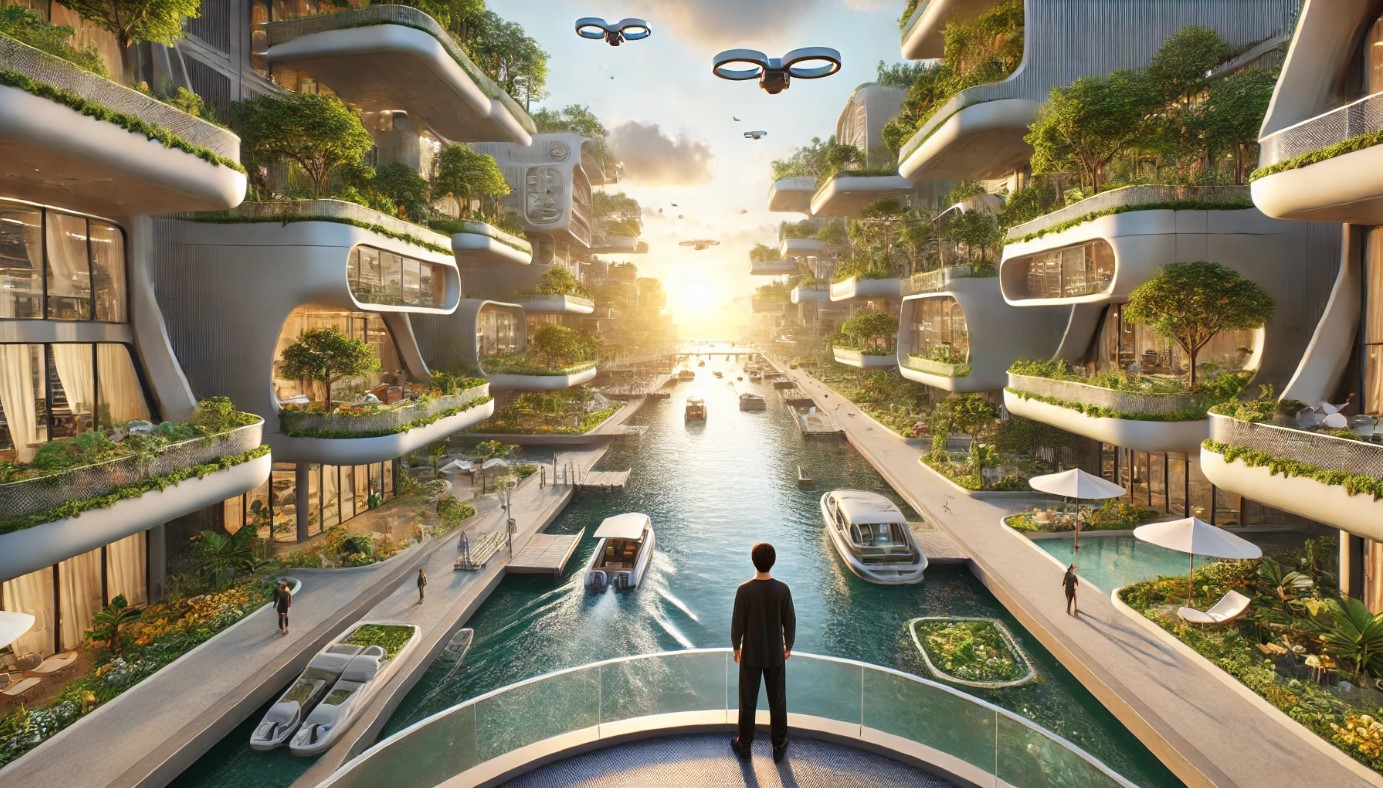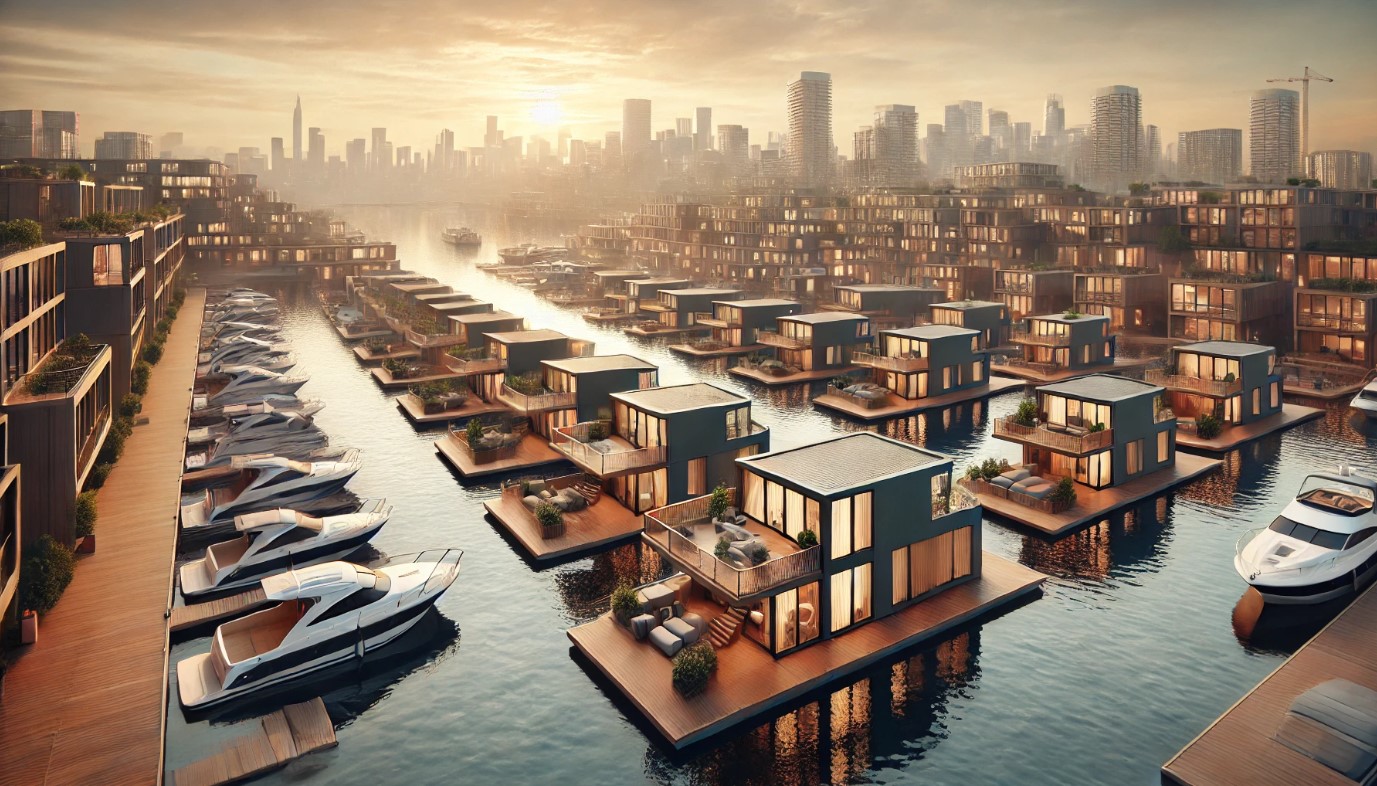As we continue our exploration of the evolving landscape of water-based communities, it’s clear that the journey from land to sea is not just a leap into the future but a carefully considered transition that begins with one of the most accessible and adaptable forms of marine living—houseboats. In my previous articles, such as “The Economic Tide: The Potential of Water-Based Societies“ and “Envisioning Society, Culture, and Lifestyle in Tomorrow’s Water-Based Communities,” we have discussed the vast potential and the innovative strides we are making toward embracing life on water. Now, let’s delve into why houseboats represent the crucial first step in this monumental shift.

Houseboats as the Gateway to Oceanic Living
In many ways, houseboats offer the perfect blend of the familiar comforts of land-based homes with the unique opportunities presented by life on the water. They serve as an ideal starting point for individuals and families who are ready to embrace a marine lifestyle but prefer a gradual transition. This approach mirrors the thoughtful design and planning necessary to foster sustainable and resilient water-based communities, a topic I explored in “Blueprint for Tomorrow: Aqua Urbanism Explained.“

1. A Familiar Foundation with a Marine Twist
Houseboats provide an environment that is both innovative and comfortably familiar. Unlike more radical oceanic structures, houseboats are designed to mimic the layout and amenities of a traditional home, allowing residents to maintain their routines while gradually adapting to life at sea. This balance between innovation and familiarity is essential in ensuring that the transition from land to sea is both smooth and sustainable.
In “The Art and Science of Designing Floating Gardens,“ I emphasized the importance of integrating familiar elements into new environments to ease transitions and foster a sense of belonging. Houseboats exemplify this principle, offering a living space that is both novel and comforting.

2. Mobility provides Freedom and Flexibility
One of the most compelling aspects of houseboat living is the inherent mobility it offers. Unlike static land-based homes, houseboats allow their residents to explore different environments and communities, making them an excellent option for those who value flexibility. This mobility not only provides the freedom to experience various marine environments but also allows residents to adapt to changes in weather and location, ensuring safety and comfort.
As I discussed in “Floating Markets & Its Economy for Water-Based Communities,“ mobility and adaptability are key components of a thriving water-based economy. Houseboats embody these qualities, making them a vital part of the larger vision for sustainable marine living.

3. An Economical and Scalable Option
Entering the world of marine living doesn’t have to come with an overwhelming financial burden. Houseboats offer a more affordable entry point compared to larger floating structures or underwater habitats. This cost-effectiveness is particularly appealing for individuals and families who are testing the waters of oceanic living.
Moreover, houseboats are highly scalable, allowing residents to start small and expand as they become more comfortable with their new lifestyle. This scalability is in line with the principles I outlined in “Off-Grid Floating Cities: Pioneering Self-Sufficient Marine Living,“ where gradual expansion and adaptability are crucial for the development of sustainable marine communities.

4. Customization and Personalization
One of the key attractions of houseboat living is the ability to customize and personalize the space to meet specific needs and preferences. Whether it’s installing eco-friendly systems, optimizing space, or creating a luxury retreat, houseboats can be tailored to reflect the unique lifestyle of their inhabitants.
This customization aligns with the ideas I presented in “Waterborne Wellness with Floating Spas and Health Resorts,“ where I highlighted the importance of creating spaces that not only meet practical needs but also enhance well-being and quality of life.

Navigating the Transition from Land to Sea
For those considering the move from land to sea, starting with a houseboat is a logical and manageable first step. Here are the key considerations to keep in mind:
1. Evaluate Your Lifestyle Needs
Before making the transition, it’s important to assess whether marine living aligns with your lifestyle and values. Consider factors such as your connection to nature, desire for adventure, and willingness to embrace a more sustainable way of life.
2. Explore Your Options
Research potential locations and houseboat designs to find the right fit for your needs. Consider the climate, local regulations, and the availability of services. Starting with a short-term rental can provide valuable insight into whether this lifestyle is right for you.
3. Plan Financially
Understand the costs involved, from the initial purchase and customization to ongoing maintenance and mooring fees. A detailed financial plan will help ensure a smooth transition.
4. Embrace the Learning Curve
Living on a houseboat involves developing new skills, from basic boat maintenance to navigation and understanding marine ecosystems. Embrace this learning curve as part of the adventure and preparation for more advanced oceanic living.
5. Build a Community
As with any significant lifestyle change, building a support network is essential. Connect with other houseboat residents and marine living enthusiasts to share experiences, advice, and resources.

Case Studies: Real-World Transitions from Land to Sea
To illustrate the growing trend of oceanic living and the role of houseboats as the initial step, let’s explore a few real-world case studies of individuals and communities who have successfully made the transition from land to sea.
1. The Narrowboat Community, United Kingdom
The UK’s Narrowboat community offers a unique perspective on water-based living. Narrowboats, traditionally used for transporting goods along the UK’s extensive canal system, have been repurposed into full-time homes by a growing community of waterway dwellers. This lifestyle, often referred to as “continuous cruising,” allows residents to live sustainably and affordably, moving from place to place along the canals.

The narrowboat community exemplifies a minimalist yet fulfilling lifestyle, where residents trade the spaciousness of land-based homes for the tranquility and simplicity of life on water. This case study underscores how houseboats—particularly narrowboats—can provide a viable alternative to traditional housing, especially in regions with rich canal networks. It also highlights the adaptability of water-based living, as residents can choose to either settle in one place or continuously explore new environments.

2. The Amsterdam Houseboat Community
Amsterdam is home to one of the most well-known houseboat communities in the world. With over 2,500 houseboats lining the city’s historic canals, Amsterdam’s residents have embraced water-based living as a practical and sustainable solution to urban housing challenges. This community demonstrates how houseboats can blend seamlessly with urban life, offering a unique living experience without sacrificing proximity to city amenities. The Amsterdam case underscores the potential for houseboats to become integral to urban planning in water-rich cities.

3. Sausalito Floating Homes, California
In the picturesque town of Sausalito, California, a thriving community of over 400 floating homes has taken root along Richardson Bay. These floating homes, many of which began as simple houseboats, have evolved into luxurious and highly sought-after residences. The Sausalito case study highlights the scalability and customization potential of houseboats, as residents have progressively upgraded their homes to include modern amenities and eco-friendly features, making this community a model for sustainable and comfortable oceanic living.

4. Kerala’s Houseboat Tourism, India
Kerala, a state in southern India, has transformed its traditional kettuvallam (houseboats) into a successful tourism industry, attracting visitors from around the world to experience life on the serene backwaters. These houseboats offer a blend of cultural heritage and modern comfort, providing guests with an immersive experience of living on water. Kerala’s houseboat tourism industry not only demonstrates the economic potential of houseboats but also shows how they can be adapted for various purposes beyond permanent residency.

Conclusion
These case studies provide concrete examples of how houseboats are already being used to meet the demands of modern living in various parts of the world. Whether it’s blending with urban environments, creating sustainable tourism opportunities, or forming the foundation of new floating neighborhoods, these examples highlight the versatility and potential of houseboats as the first step in the transition from land to sea.
At V-Marine, we draw inspiration from these real-world examples as we design and manufacture houseboats that not only meet the highest standards of luxury and sustainability but also contribute to the broader vision of oceanic living.
As we continue to explore and expand the possibilities of oceanic living, houseboats represent the crucial first step in this exciting journey. They offer a balanced approach to transitioning from land to sea, combining the comforts of a traditional home with the unique opportunities presented by life on water. Whether you are drawn by the freedom of mobility, the allure of customization, or the promise of a more sustainable lifestyle, houseboats provide an ideal entry point into the world of marine living.

At V-Marine, we are imagining the future of oceanic living and actively shaping it. With our range of exquisitely designed, state-of-the-art houseboats, we are committed to making the transition from land to sea a seamless and enriching experience. Our houseboats are floating homes that we believe are a gateway to a new way of life. Each V-Marine houseboat is crafted to provide the perfect balance of comfort and adventure, allowing you to embrace marine living while staying connected to the familiar comforts of home. As we continue to push the boundaries of what is possible on water, we invite you to join us in realizing this vision, one houseboat at a time.



